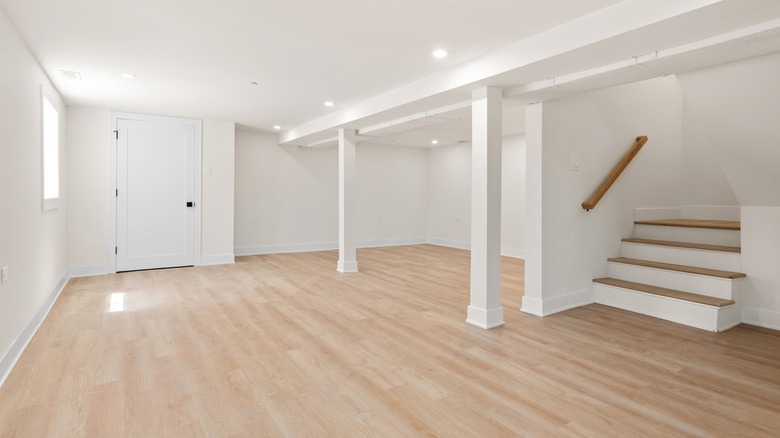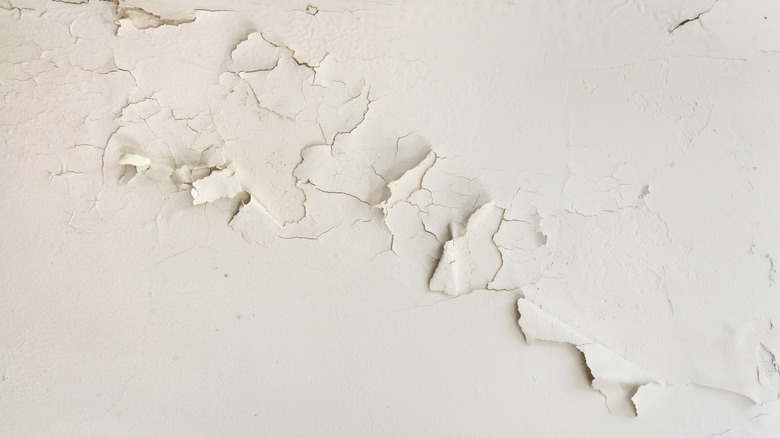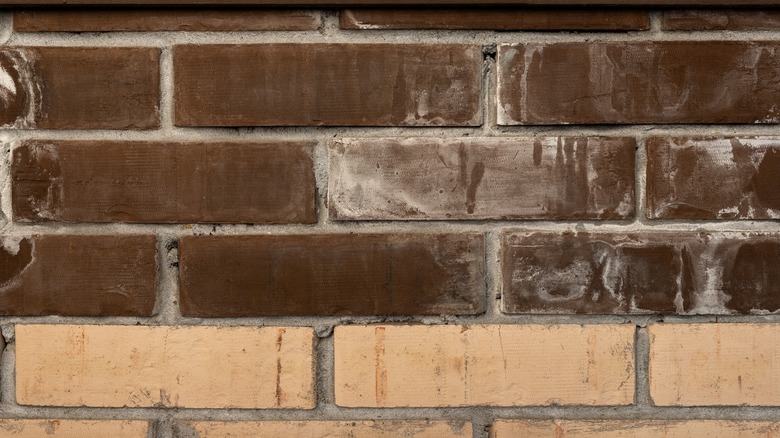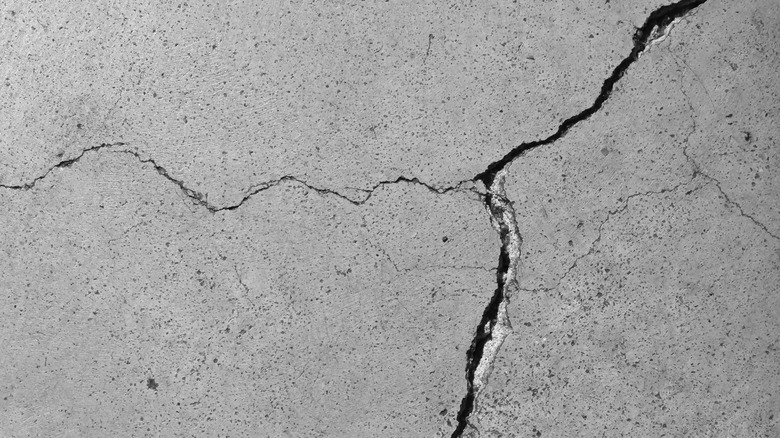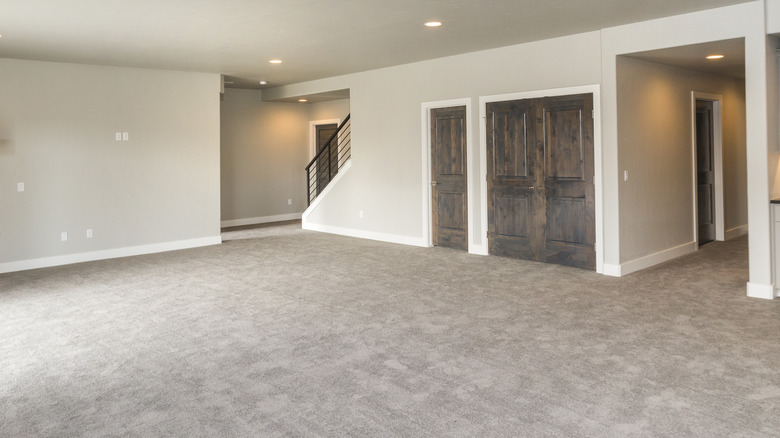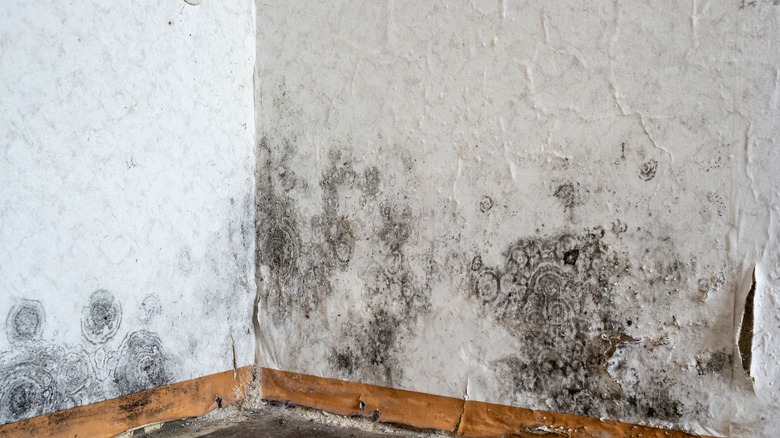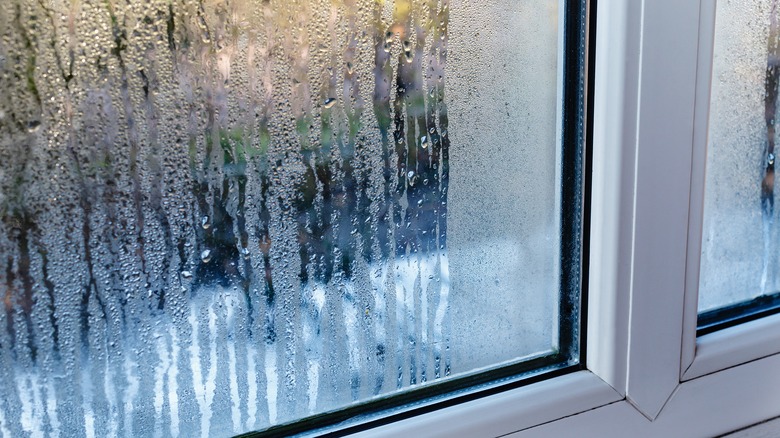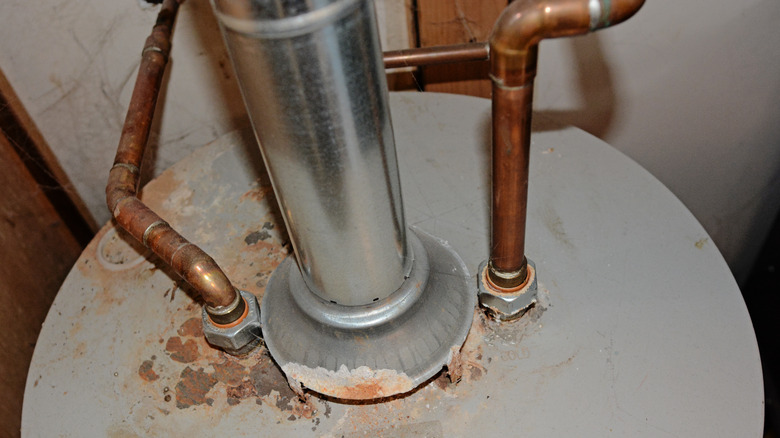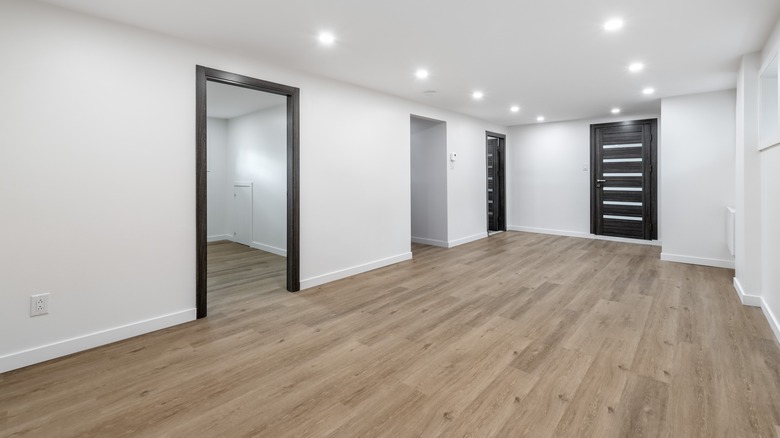Tell-Tale Signs Of Water Damage In A Remodeled Basement
Looking for a new home can be stressful. One of the most stressful parts of the search can be going to open houses and showings. You only have a few minutes inside each home to decide whether it is right for you. Beyond considering the floor plan and available space, you also need to assess the overall condition of the house. One important thing you won't want to overlook is the signs of water damage in a remodeled basement. Many homeowners refinish their basements before selling their homes to increase the property value, but sometimes, there may be hidden damage lurking under that new flooring or those newly painted walls.
To help you spot the telltale signs, two professional contractors shared exclusive tips with House Digest so that we could help you identify some of the most common signs of water damage in a remodeled basement. Continue reading to learn more about what you should be on the lookout for — and whether they should impact your decision about whether to buy a particular home.
A musty smell or damp odors can signal the presence of water damage
If you're viewing a potential new home, note any smells you notice as you walk into the basement. Smells that are off, particularly those that are damp and musty, should not be overlooked. In an exclusive interview with House Digest, Bill Bencker, a professional contractor specializing in concrete and building structures with Ace Avant Concrete Construction, said, "This smell isn't just a minor annoyance — it's often an indicator that moisture is building up somewhere it shouldn't be, creating an ideal home for mold and mildew."
Bencker explains that the smell might be caused by humidity levels that are too high, or a potentially more serious source of trickling water that is hidden somewhere nearby. The source of the problem — and the extent of the damage that has already been done — will dictate the next steps and necessary repairs. "Sometimes a dehumidifier is enough, but for bigger issues, you may need a sump pump or a ventilation system to keep air moving and moisture out. On the low end, you might spend around $1,000 to install basic ventilation, but adding a sump pump system could bring the total closer to $3,000." Having a home inspector or another professional examine the scope of the damage for you can help you make an informed decision about whether you want to put an offer in on the home.
Look out for peeling paint or bubbling wallpaper as they often come alongside water damage
Take note of the condition of the walls when walking around the basement of a prospective home. Peeling paint or wallpaper that is bubbling up sometimes indicates the presence of termites, but more often than not, these are two indicators that there is water damage behind the walls. "This can happen if the walls weren't sealed correctly during the remodel. Minor cases can often be touched up with a waterproof sealant, but if moisture has been soaking the drywall or wood for a while, you'll likely need to replace those sections entirely," says Bencker.
This is another instance where the expertise of a professional can help you evaluate the extent of the damage. Touching up the area with a waterproof sealant should be relatively easy and inexpensive. However, as Bencker explains, fixing a more extensive water issue "with a professional waterproofing treatment can cost between $1,000 and $5,000, depending on how big an area is affected and whether there's underlying damage to repair." Buying a house that needs such an expensive repair right off the bat might be enough to turn you away. Or, if you're still set on the home, you could always ask for a concession when you submit a contract with your real estate agent.
A white, powdery substance on concrete walls can spell trouble
Don't forget to look over the entire basement — including portions that aren't finished, such as a crawl space in the back or the utility closet. If there are concrete walls in any of these unfinished areas, look closely for a powdery, white substance covering them. Bencker explains that this substance is called efflorescence. Before giving up on the home right away, you should know that the presence of efflorescence itself isn't catastrophic. It is just the mineral deposits that are left behind from water moving through the concrete wall. In some cases, the moisture might not be a big deal if there is plumbing behind the walls.
However, as Bencker explains, efflorescence can spell more serious trouble at times. He says, "It's a warning sign that moisture is present and could eventually lead to more significant issues. You can clean it off and use a concrete sealant to prevent further buildup, but if water is getting through, you'll need to address that." Hiring a professional to seal the area may cost between $500 and $2,500, Bencker estimates.
Large or widening cracks in the walls or floors are not a good sign
As you're touring a remodeled basement in a potential home, look for any cracks on the walls or the floor. A few smaller cracks (under ⅛ inch wide), probably aren't cause for concern, according to Bencker. However, if the cracks you spot are any wider than this, he explains that it could be a sign of water getting under the surface. "Water infiltration can cause soil to shift under the foundation, which then creates cracking."
Cracks are not something you should ignore. If you're going to purchase the home, be prepared to address them promptly. As Bencker explains, "Left alone, these cracks can worsen, leading to structural shifts or even foundation problems." While smaller cracks may only cost up to $800 to repair by hiring a professional to fill them, foundation repair or underpinning may be necessary to fix the underlying causes of larger cracks. He estimates that such repairs could cost $3,000 to $10,000, so you could be out a lot of money shortly after closing on your new home.
Spongy flooring often indicates that there is water damage
Take note of not just what the floor looks like, but also how it feels as you walk around a basement. "If the floor feels damp or spongy when you step on it, there's likely water sneaking in either from below the concrete slab or through the walls," explains Bencker. He explains that the likely cause of the moisture reaching the floor is the lack of a moisture barrier under the tile, vinyl, or other material.
In some cases, repairs might not be drastic. If such an issue is caught early enough, he notes that pulling up the flooring and putting a vapor barrier down before reinstalling it may be sufficient. However, he also mentions, "If there's ongoing water pressure, installing a French drain or additional drainage might be necessary." Depending on the scope of the work to be done, Bencker estimates you should be prepared to spend between $1,500 and $6,000 for a French drain — plus the cost of new flooring that will likely be necessary if the existing one was damaged by the moisture.
Mold or mildew on baseboards or walls often comes alongside water damage
Many signs of water damage in a remodeled basement are lurking behind the walls or beneath the floor. However, some may be right out in the open. "Seeing mold or mildew in a freshly remodeled basement is never a good sign. Not only is mold a clear indicator of moisture problems, but it can also affect the air quality, leading to health risks for anyone spending time down there," explains Bencker.
You'll need to hire a professional to remediate the mold, which could cost a few hundred or thousands of dollars, depending on the extent of the problem. If you don't address the root cause of the problem, the mold will only return, bringing all of the air quality and health concerns with it. "Solving the underlying problem could mean anything from installing better drainage to a comprehensive waterproofing project, depending on the water source," explains Bencker. If the culprit isn't clear, ask your home inspector or hire a waterproofing expert to help you pinpoint it before moving forward with the purchase.
Look out for condensation on the windows as it might be indicative of water damage
Not all remodeled basements will have windows, but some will. If the basement you're looking at does have windows, be sure to look at them — and not just to check out the view. "Another sign to watch for is excess moisture on window surfaces, especially during colder months. This condensation occurs when humidity levels are high in the basement, causing moisture to collect on the cooler glass surfaces," Andriy Boyko, Founder of A.O. Handy Inc., shared with House Digest during an exclusive interview.
Generally speaking, noticing water on the inside of the windows doesn't spell the big trouble that some other signs of water damage do. Boyko explains, "To remedy this, you can reduce humidity levels with dehumidifiers and proper ventilation." He also highlights adding insulated windows as another potential solution. Boyko notes that a dehumidifier should only cost up to $400, while insulated windows can cost between $300 and $800 each. However, if you do decide to purchase the house, be sure to monitor the situation. If the condensation is persistent, it could result in mold growing.
Rusting pipes or appliances can also be caused by water
As you're walking through any unfinished spaces in the basement, such as the utility closet, take a close look at any exposed pipes, the water heater, and any other appliances with metal components. Boyko says to look for corrosion or rust on any of these surfaces. He explains, "This condition often indicates a slow leak or high humidity in the area. Rusting can be a significant concern, as it may lead to pipe failure or appliance malfunctions, resulting in considerable water damage."
If you decide to purchase the home, you'll want to replace rusted pipes to prevent a catastrophic malfunction or leak. Boyko explains that the level of rusting will impact the cost of replacement, with most corroded pipes costing between $300 and $1,500 to replace. If the components of the water heater are also rusted, you'll want to budget up to $1,500 to purchase a new one. If you haven't made an offer on a home yet, consider asking your real estate agent to add the request that the homeowner will pay for these repairs.
Slopes and dips in the floors are not normal and may be caused by water
While you're taking your time walking around the basement to inspect the pipes, walls, windows, and other elements, don't overlook the feel of the ground beneath your feet. If you ever feel like you're walking slightly up or down hill or notice a dip in the ground, it may be a sign of a hidden, yet major, issue.
Boyko explains, "Sinking or uneven floors could indicate foundation issues caused by water erosion or soil settling. This is a serious concern, as uneven floors can signify significant structural problems." You might want to hire a professional to look into the issue further before finalizing your decision to make an offer on the home. "Depending on the cause, you may require foundation repair, which can range from $1,500 to $10,000," shares Boyko.
